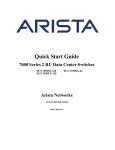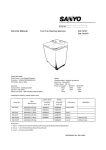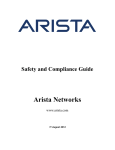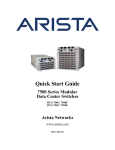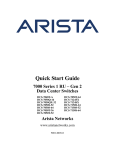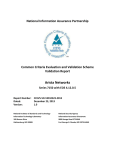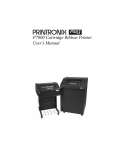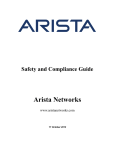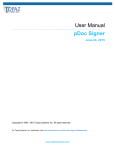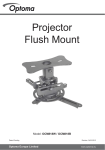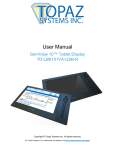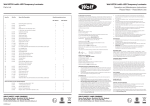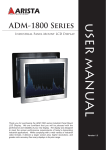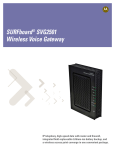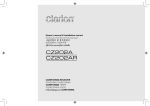Download 7010T QSG
Transcript
Quick Start Guide 7010 Series 1 RU Data Center Switches DCS-7010T-48 DCS-7010T-48-DC Arista Networks www.arista.com PDOC-00061-03 Headquarters Support Sales 408 547-5500 408 547-5502 866 476-0000 408 547-5501 866 497-0000 www.arista.com [email protected] [email protected] 5453 Great America Parkway Santa Clara, CA 95054 USA © Copyright 2015 Arista Networks, Inc. The information contained herein is subject to change without notice. Arista Networks and the Arista logo are trademarks of Arista Networks, Inc in the United States and other countries. Other product or service names may be trademarks or service marks of others. Chapter 1 Overview 1.1 Scope This guide is intended for properly trained service personnel and technicians who need to install the following Arista Networks Data Center Switches: • DCS-7010T-48 • DCS-7010T-48-DC Important! Only qualified personnel should install, service, or replace this equipment. 1.2 Receiving and Inspecting the Equipment Upon receiving the switch, inspect the shipping boxes and record any external damage. Retain packing materials if you suspect that part of the shipment is damaged; the carrier may need to inspect them. If the boxes were not damaged in transit, unpack them carefully. Ensure that you do not discard any accessories that may be packaged in the same box as the main unit. Inspect the packing list and confirm that you received all listed items. Compare the packing list with your purchase order. Appendix C provides a list of components included with the switch. 1.3 Installation Process The following tasks are required to install and use the switch: Step 1 Step 2 Step 3 Step 4 Step 5 Select and prepare the installation site (Section 2.1). Assemble the installation tools listed in Section 2.2. Attach the mounting brackets and install the switch in an equipment rack (Chapter 3). Connect the switch to the power source and network devices (Chapter 4). Configure the switch (Chapter 6). Important! Class 1 Laser Product: This product has provisions to install Class 1 laser transceivers which provide optical coupling to the communication network. Once a Class 1 laser product is installed, the equipment is a Class 1 Laser Product (Appareil à Laser de Classe 1). The customer is responsible for selecting and installing the Class 1 laser transceiver and for insuring that the Class 1 AEL (Allowable Emission Limit) per EN/IEC 6-825, CSA E60825-1, and Code of Federal Regulations 21 CFR 1040 is not exceeded after the laser transceiver have been installed. Do not install laser products whose class rating is greater than 1. Refer to all safety instructions that accompanied the transceiver prior to installation. Only Class 1 laser devices, certified for use in the country of installation by the cognizant agency are to be utilized in this product. Important! Ultimate disposal of this product should be in accordance with all applicable laws and regulations. 1.4 Safety Information Refer to the Arista Networks document Safety Information and Translated Safety Warnings available at: http://www.arista.com/support/docs/eos 7010 Series 1 RU Quick Start Guide PDOC-00061-03 3 Chapter 1: Overview 1.5 Obtaining Technical Assistance Any customer, partner, reseller or distributor holding a valid Arista Service Contract can obtain technical support in any of the following ways: • Email: [email protected]. This is the easiest way to create a new service request. Include a detailed description of the problem and the output of “show tech-support”. • Web: www.arista.com/support. A support case may be created through the support portal on our website. You may also download the most current software and documentation, as well as view FAQs, Knowledge Base articles, Security Advisories, and Field Notices. • Phone: 866-476-0000 or 408-547-5502. Important! No user serviceable parts inside. Refer all servicing to qualified service personnel. 1.6 Specifications Table 1 lists the specifications of Arista Data Center switches covered by this guide. Table 1: Switch Specifications 4 Size (W x H x D) all switches 44.5 x 4.4 x 25.4 cm (19 x 1.75 x 10 inches) Weight all switches 4.3 kg (9.5 pounds) Operating Temperature Storage Temperature Operating Altitude Relative Humidity all switches all switches all switches all switches 0° to 40° C (32° to 104° F) -25° to 70° C (-13° to 158° F) 0 to 3,000 meters (0 to 10,000 feet) 5 to 95% Power Input (AC Power) Power Input (DC Power) DCS-7010T-48 DCS-7010T-48-DC 100 – 240 VAC, 0.96 – 0.48 A, 50/60 Hz 40 – 72 (absolute) VDC, 1.8– 1.0 A Power Draw (Typical / Maximum) all switches 52 W / 65 W Arista Networks Copyright 2014 Chapter 2 Preparation 2.1 Site Selection The following criteria should be considered when selecting a site to install the switch: • Temperature and Ventilation: For proper ventilation, install the switch where there is ample airflow to the front and back of the switch. The ambient temperature should not go below 0° or exceed 40° C. Important! To prevent the switch from overheating, do not operate it in an area where the ambient temperature exceeds 40°C (104°F). • Airflow Orientation: Determine front and rear aisle temperatures and verify that fan is inserted appropriately for switch installation. The fan orientation determines the airflow direction through the switch. The fan orientation is changed by removing the fan from the switch, rotating it 180°, then re-inserting it into the switch. The color of the visible label indicates the airflow direction. Figure 1 displays the rear panels of two switches with different fan orientations: — Blue Label visible: Air Inlet direction. — Red Label visible: Air Exit direction. Orient the fan direction to assure the air inlet always faces the cool aisle: — Air Exit label visible: orient front panel toward cool aisle. — Air Inlet label visible : orient front panel toward hot aisle. Appendix A describes the process of changing the fan orientation. Fan Status LED PS1 ASY SN FAN FAN-7010 7010T-48 Orientation: Air Inlet STATUS AIR INLET AIR EXIT 180 O FAN STATUS MAC Fan Module Handle PS1 SN FAN STATUS AIR INLET FAN-7010 7010T-48 ASY INPUTS (2) ( ): 100-240V~50/60Hz 0.74-0.30A (0,74-0,30A) INLET Air Inlet Indicator Orientation: Air Exit PS2 EXIT MAC Air Exit Indicator AIR EXIT PS2 EXIT 180 O FAN STATUS INLET INPUTS (2) ( ): 100-240V~50/60Hz 0.74-0.30A (0,74-0,30A) Fan Status LED Figure 1: Rear Panels with Contrasting Fan Module Orientation • Rack Space: Install the switch in a 19" rack (cabinet) or place it on a flat surface. The switch height is 1 RU. The accessory kit provides brackets for rack mounting and rubber pads for a flat surface placement. • Power Requirements: Refer to Table 1. Two circuits provide redundancy protection. Chapter 4 describes power cable requirements. Important! The power input plug-socket combination must be accessible at all times; it provides the primary method of disconnecting power from the system. 7010 Series 1 RU Quick Start Guide PDOC-00061-03 5 Chapter 2: Preparation • Other Requirements: Select a site where liquids or objects cannot fall onto the equipment and foreign objects are not drawn into the ventilation holes. Verify these guidelines are met: — Clearance areas to the front and rear panels allow for unrestricted cabling. — All front and rear panel indicators can be easily read. — Power cords can reach from the power outlet to the connector on the rear panel. Important! All power connections must be removed to de-energize the unit. 2.2 Tools Required for Installation Each switch provides an accessory kit that contains parts that are required to install the switch. In addition to the accessory kit, the following tools and equipment are required to install the switch: Rack Mount (Two-Post or Four-Post) • • Screws or rack mounting nuts and bolts. #2 Phillips Screwdriver Flat Surface Placement No additional equipment required. Accessory kit does not include screws for attaching the switch to the equipment rack. When installing the switch into an equipment rack with unthreaded post holes, nuts are also required to secure the switch to the rack posts. 2.3 Electrostatic Discharge (ESD) Precautions Observe these guidelines to avoid ESD damage when installing or servicing the switch. • • • • • • • 6 Assemble or disassemble equipment only in a static-free work area. Use a conductive work surface (such as an antistatic mat) to dissipate static charge. Wear a conductive wrist strap to dissipate static charge accumulation. Minimize handling of assemblies and components. Keep replacement parts in their original static-free packaging. Remove all plastic, foam, vinyl, paper, and other static-generating materials from the work area. Use tools that do not create ESD. Arista Networks Copyright 2014 Chapter 3 Mounting the Switch Important! The rack mounting procedure is identical for all switches covered by this guide. Illustrations in this chapter depict the mounting of a DCS-7010T-48 switch. The switch can be mounted in a rack or operated from a flat surface, such as a table. • • Section 3.1 provides instructions for mounting the switch in a two-post or four-post rack. Section 3.2 provides instructions for a flat surface placement. After completing the selected instructions, proceed to Chapter 4: Powering the Switch. 3.1 Rack Mount The switch can be installed in a two-post or four-post rack. Because it attaches to only two posts of a rack, the installation process for each type of rack is identical. When rack mounting a switch that was previously prepared for a surface placement, remove the rubber pads from the bottom of the switch. To mount the switch in a rack, assemble the mounting brackets to the chassis, then attach the brackets to the rack posts. Rack mount accessory kits include the following parts: • 2 mounting brackets • 6 M4x5 flat head Phillips screws Figure 2 displays the proper bracket mount. Figure 2: Bracket Mount Placement for Rack Mount 3.1.1 Attaching Mounting Brackets to the Chassis This procedure attaches mounting brackets to the switch chassis (Figure 3). Step 1 Align the mounting brackets with the chassis holes at the front of the switch. Step 2 Attach the brackets with two M4x5 flat head Philips screws. Attaching the bracket Figure 3: Attaching the Mounting Brackets to the Switch Chassis 7010 Series 1 RU Quick Start Guide PDOC-00061-03 7 Chapter 3: Mounting the Switch 3.1.2 Inserting the Switch into the Rack This procedure attaches the switch to the rack (Figure 4). Step 1 Lift the chassis into the rack. Position the flanges against the rack posts. Figure 4: Inserting the Switch into the Rack Step 2 Select mounting screws that fit your equipment rack. Step 3 Attach the bracket flanges to the rack posts. After completing the rack mount, proceed to Chapter 4: Powering the Switch. 3.2 Flat Surface Placement The switch is prepared for flat surface placement by attaching four rubber pads on the bottom of the chassis to prevent the switch from sliding on the table and to protect the surface of the table. The installation kit provides the following four-post mounting parts: • Four rubber switch pads To prepare the switch for placement on a flat surface, peel the four rubber pads from the master sheet and attach one in each indentation near each corner on the bottom of the switch. Figure 5 displays the attachment of the rubber pads to the bottom of the switch. Note: 8 Rubber pads are not typically used for rack mount installations. Arista Networks Copyright 2014 This indented stand-off is no longer present. Figure 5: Attaching Rubber Pads to Bottom of Switch 7010 Series 1 RU Quick Start Guide PDOC-00061-03 9 Chapter 4: Powering the Switch Chapter 4 Powering the Switch Important! Installation of this equipment must comply with local and national electrical codes. If necessary, consult with the appropriate regulatory agencies and inspection authorities to ensure compliance. The switch operates with two internal power supplies. At least one power supply must connect to a power source. Two circuits provide redundancy protection. Appendix E displays the location of the power sockets (AC) or terminals (DC) on the rear panel of all switches covered by this guide. This chapter includes sections that describe procedure for grounding and cabling AC and DC power supplies. After completing the instructions for your switch, proceed to Chapter 5: Connecting Serial and Management Cables. Important! Read all installation instructions before connecting the system to the power source. • • • Non-Redundant Configuration: Connect power to either of the two power supplies. Redundant Power Supply Configuration: Connect power to both power supplies. Power down the Switch: Remove all power cords and wires from the power supplies. Important! This equipment must be grounded. Never defeat the ground conductor. Important! This unit requires overcurrent protection. 4.1 Cabling the AC Power Supply (DCS-7010T-48) 4.1.1 Grounding the Switch After mounting the switch into the rack, connect the switch to the data center ground. Figure 6 displays the location of the grounding pads located on the right side of the rear panel. Important! Grounding wires and grounding lugs are not supplied. Wire size should meet local and national installation requirements. Commercially available 12 AWG wire is recommended for U.S. installations. M4x0.7 screws are required to secure the wire to the grounding pad. PS1 SN FAN STATUS AIR INLET FAN-7010 7010T-48 ASY AIR EXIT PS2 EXIT 180 O FAN STATUS MAC INPUTS (2) ( ): 100-240V~50/60Hz 0.74-0.30A (0,74-0,30A) INLET AC Power Socket Earth AC Power Grounding Socket Pad Figure 6: Earth Grounding Pad and AC Power Sockets 4.1.2 Connecting Power Cables to the AC Supply AC power supplies require circuits that provide 100-240 VAC, 50 or 60 Hz, and 0.96-0.48 A. Figure 6 shows the location of the AC power sockets on the rear switch panel. Power supplies use cables that comply with IEC-320 and have a C13 plug. The accessory kit provides two IEC-320 C13 to C14 power cables. 10 Arista Networks Copyright 2014 4.2 Cabling the DC Power Supply (DCS-7010T-48-DC) Figure 7 displays the location of the earth grounding pad and the DC input terminals. DC PS1 PE Ground 7010T- 48-DC ASY SN FAN STATUS AIR INLET FAN-7010 + - AIR EXIT INPUTS (2) ( )( ) 40-72V EXIT 180 PS2 O DC + - PE Ground FAN STATUS MAC INLET Input Terminals Earth Grounding Pad Input Terminals Figure 7: DC Input Terminals and DC Grounding Pad Figure 8 displays DC power terminals on the left side of the rear panel with the terminal cover in place (left illustration) and with the terminal cover removed (right illustration). DC PS1 DC PS1 + - + - + – PE Ground Figure 8: DC Input Terminals – terminal cover in place (left); terminal cover removed (right) Important! Grounding lugs for the earth grounding pads and grounding wires are not supplied. M4 screws are required. Wire size should meet local and national installation requirements. Recommended grounding wire sizes are 6 AWG (earth ground) and 16 AWG (PE ground). M4x0.7 screws are required to secure the wire to the grounding pads. Screws are pre-installed for the PE ground terminals. Each DC input terminal accepts insulated crimp-on spade lugs, insulated crimp-on ring connectors, or bare wires. Important! Using crimp-on connectors are safer than bare wires. Ensure the wires connecting the DC power supply to the power source meet the following: • • • • DC Input Wire Size: 14 AWG (1.5 mm2) to 18 AWG (0.75 mm2) PE Ground Wire Size: 14 AWG (1.5 mm2) to 18 AWG (0.75 mm2) Wire Terminal (Lug): ring or spade, 14-16 AWG, #6 / M3.5 screw Overcurrent protection: 20 A. Important! Wire size must comply with local and national requirements and electrical codes. Use only copper wire. DC power supplies require 40 – 72 VDC (absolute voltage) and draws 1.8 – 1.0 A. The power supply has reverse polarity protection. Important! Before performing any installation actions, ensure power is removed from DC circuits by turning off the power line circuits on DC power lines servicing the circuits. Apply the ground connection first during installation and remove last when removing power. To connect a DC power supply to a power source: Step 1 Attach the secondary grounding pad to the Data Center ground (Figure 7). Step 2 Remove the terminal cover to expose the connectors (Figure 8). Step 3 Attach the appropriate lugs to the source DC wires. 7010 Series 1 RU Quick Start Guide PDOC-00061-03 11 Step 4 Connect the DC-input wires to the terminal block in this order: 1. Ground cable to the PE Ground connector on the terminal block. 2. Negative (–) source DC cable to the negative (–) connector on the terminal block. 3. Positive (+) source DC cable to the positive (+) connector on the terminal block. Step 5 Replace the terminal cover. 7010 Series 1 RU Quick Start Guide PDOC-00061-03 12 Chapter 5: Connecting Serial and Management Cables Chapter 5 Connecting Serial and Management Cables The front panel contains the console, management, and USB ports. Figure 9 displays the ports on the DCS-7010T-48 switch. Appendix D displays the front panel of all switches covered by this guide. Console (Serial) Port Ethernet Management Port USB Port Figure 9: Front Panel Ports Connect the front panel ports as follows: • Console (Serial) Port: Connect to a PC with a serial adapter cable. The switch uses the following default settings: — — — — — 9600 baud No flow control 1 stop bit No parity bits 8 data bits • Ethernet Management Port: Connect to 100/1000 management network with RJ-45 Ethernet cable. • USB Port: The USB port may be used for software or configuration updates. Caution Excessive bending can damage interface cables, especially optical cables. 7010 Series 1 RU Quick Start Guide PDOC-00061-03 13 Chapter 6: Configuring the Switch Chapter 6 Configuring the Switch Arista switches ship from the factory in Zero Touch Provisioning (ZTP) mode. ZTP configures the switch without user intervention by downloading a startup configuration file or a boot script from a location specified by a DHCP server. To manually configure a switch, ZTP is bypassed. The initial configuration provides one username (admin) accessible only through the console port because it has no password. When bypassing ZTP, initial switch access requires logging in as admin, with no password, through the console port. Then you can configure an admin password and other password protected usernames. This manual configuration procedure cancels ZTP mode, logs into the switch, assigns a password to admin, assigns an IP address to the management port, and defines a default route to a network gateway. Step 1 Provide power to the switch (Chapter 4). Step 2 Connect the console port to a PC (Section 5). As the switch boots without a startup-config file, it displays the following through the console: The device is in Zero Touch Provisioning mode and is attempting to download the startup-config from a remote system. The device will not be fully functional until either a valid startup-config is downloaded from a remote system or Zero Touch Provisioning is cancelled. To cancel Zero Touch Provisioning, login as admin and type 'zerotouch cancel' at the CLI. localhost login: Step 3 Log into the switch by typing admin at the login prompt. localhost login:admin Step 4 Cancel ZTP mode by typing zerotouch cancel. IMPORTANT: This step initiates a switch reboot. localhost>zerotouch cancel Step 5 After the switch boots, log into the switch again by typing admin at the login prompt. Arista EOS localhost login:admin Last login: Fri Mar 15 13:17:13 on console Step 6 Enter global configuration mode. localhost>enable localhost#config Step 7 Assign a password to the admin username with the username secret command. localhost(config)#username admin secret pxq123 Step 8 Configure a default route to the network gateway. localhost(config)#ip route 0.0.0.0/0 192.0.2.1 Step 9 Assign an IP address (192.0.2.8/24 in this example) to an Ethernet management port. localhost(config)#interface management 1 localhost(config-if-Ma1/1)#ip address 192.0.2.8/24 Step 10 Save the configuration by typing write memory or copy running-config startup-config. localhost#copy running-config startup-config When the management port IP address is configured, use this command to access the switch from a host, using the address configured in step 9: ssh [email protected] Refer to the Arista Networks User Manual for complete switch configuration information. 14 Arista Networks Copyright 2014 Appendix A Fan Module Orientation Important! The procedure for changing the fan module orientation is identical for all switches covered by this guide. Illustrations in this appendix depict a DCS-7010T-48 switch. The fan module orientation determines the direction of air flowing through the switch. Figure 10 displays the rear panel with the fan module removed from the switch. The fan module, when inserted, covers one of the two airflow labels; the visible label specifies the current airflow direction. The switch shuts down when the fan module is removed for more than one minute. Fan Module (Air Exit Orientation) FAN-7010 FAN-7010 Fan Module (Air Inlet Orientation) Power Supply 1 Input Fan Module Socket Power Supply 2 Input PS1 7010T-48 ASY SN AIR EXIT FAN STATUS PS2 EXIT 180 AIR INLET O FAN STATUS MAC Airflow Vents (Intake or Exhaust) INPUTS (2) ( ): 100-240V~50/60Hz 0.74-0.30A (0,74-0,30A) INLET Airflow Label: Air Inlet Airflow Label: Air Exit Earth Grounding Pads Figure 10: Orienting the Fan Module To change the airflow direction, change the fan module orientation: Step 1 While squeezing the fan module handle, pull the fan module out of the switch. Step 2 Rotate the fan module 180° Step 3 Insert the fan module back into the switch. 7010 Series 1 RU Quick Start Guide PDOC-00061-03 15 Appendix B Status Indicators B.1 Switch Indicators Front panel LEDs are located on the right side of the front panel and display system, fan, and power supply status. Appendix D displays the front panels of all switches covered by this guide. Figure 11 displays the DCS-7010T-48 front panel LEDs. System Status LED Fan Status LED Power Supply 1 Status LED Power Supply 2 Status LED Figure 11: System Status Indicators Table 2: Switch Indicators LED States LED Name System Status Fan Status PSU [1:2] 7010 Series 1 RU Quick Start Guide LED State Device Status Blinking Green Booting. Green All system diagnostics pass. Blue Locator function active. Amber Critical temperature failure. Red System diagnostics fail. Green Fan system nominal. Amber Fan system warning. Red Fan system failure. Green PSU functioning. Off PSU not powered. PDOC-00061-03 16 Appendix B: Status Indicators B.2 Port Indicators Port LEDs, located in the vicinity of their corresponding ports, provide link and operational status. Figure 12 displays the Port LED location on the DCS-7010T-48 switch. Appendix D displays the port LED locations of all switches covered by this guide. Figure 12: Port LEDs Table 3 provides status conditions that correspond to port LED states. Port LED behavior for SFP+ and 100/1000 Base-T ports is consistent. Table 3: Port LED States LED State Status Off Port link is down. Green Port link is up. Yellow Port is software disabled. 7010 Series 1 RU Quick Start Guide PDOC-00061-03 17 Appendix B: Status Indicators B.3 Fan Module Indicator Fan module indicators are viewed from the rear panel. The fan module contains an LED that reports module status. The Fan Status LED is on the fan module, as displayed in Figure 13. Appendix E displays the Fan Status LED locations of all switches covered by this guide. Fan Status LED FAN-7010 Figure 13: Fan Status LED Table 4 provides status conditions that correspond to fan status LED states. Table 4: Fan Status LED States LED State 18 Status Off The fan module is not properly seated, or the switch is not powered. Green The fan is operating normally. Red One or more fans have failed. Flashing Green The switch is booting. Arista Networks Copyright 2014 Appendix C Parts List Each switch provides an accessory kit that contains parts that are required to install the switch. This appendix lists the installation parts contained in the switch accessory kit. C.1 Installation Parts Rack mount and flat surface placement parts are provided in the accessory kit. C.1.1 Rack Mount Parts Mounting Brackets (2) M4x5 flat head Phillips Screws (6) Figure 14: Rack Mount Parts C.1.2 Flat Surface Placement Parts Rubber Pads Figure 15: Flat Surface Placement Parts C.2 Cables Power cables are only provided for the DCS-7010T-48 switch. Table 5: Switch Cables (AC Power Supply) Quantity 2 Warning! Description Power cables: IEC-320/C13-C14, 10 A, 250 V All provided power cables are for use only with Arista products. 警告 すべての電源コードは提供する製品で使⽤するためだけを⽬的としている。 電源コードの他の製品での使⽤の禁⽌ Arista が提供するすべての電源コードは、Arista の製品でのみ使⽤してください。 7010 Series 1 RU Quick Start Guide PDOC-00061-03 19 Appendix D Front Panel This appendix displays the front panel of all switches covered by this guide. DCS-7010T-48 Figure 16: DCS-7010T-48 Front Panel DCS-7010T-48-DC Figure 17: DCS-7010T-48-DC Front Panel 7010 Series 1 RU Quick Start Guide PDOC-00061-03 20 Appendix E Rear Panel This appendix displays the rear panel of all switches covered by this guide. DCS-7010T-48 Power Supply 1 Input Fan Module (Inlet Direction) Power Supply 2 Input PS1 FAN-7010 FAN 7010T-48 STATUS ASY AIR INLET SN AIR EXIT PS2 EXIT 180 O FAN STATUS MAC Airflow Vents (Intake or Exhaust) INPUTS (2) ( ): 100-240V~50/60Hz 0.74-0.30A (0,74-0,30A) INLET Airflow Label: Air Inlet Airflow Label: Air Exit (Covered by Fan Module) Earth Grounding Pads Figure 18: DCS-7010T-48 Rear Panel DCS-7010T-48-DC Power Supply 1 Input DC Fan Module (Inlet Direction) Power Supply 2 Input PS1 7010T-48-DC ASY SN FAN FAN-7010 + - STATUS AIR INLET AIR EXIT INPUTS (2) ( )( ) 40-72V EXIT 180 O PS2 DC + - FAN STATUS MAC Airflow Vents (Intake or Exhaust) INLET Airflow Label: Air Inlet Airflow Label: Air Exit (Covered by Fan Module) Earth Grounding Pads Figure 19: DCS-7010T-48-DC Rear Panel 7010 Series 1 RU Quick Start Guide PDOC-00061-03 21 Appendix E: Rear Panel 22 Arista Networks Copyright 2014























